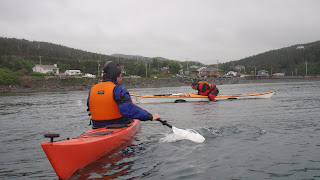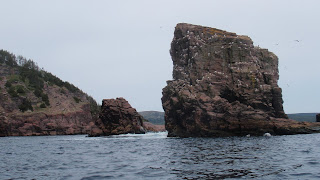
On Saturday a group of Kayak Newfoundland and Labrador members met at Colinet in St. Mary's Bay to do a kayak camping trip at the abandoned community of Tickles. It was billed on the club's website as an introduction to kayak camping and a number of paddlers took advantage. The weather in St. John's was not great but we knew the weather in St. Mary's Bay is often better when there's a northeasterly wind. Tripleader Peter made a good call and when we got to Colinet the weather was beautiful while we had left the city in fog and drizzle.
13 singles and a double were loaded with all the camping necessities and shortly after 3:00 we were ready to put-in.

After a short 3.5 km paddle from Colinet down Colinet Harbour we ducked inside into Pinchgut Tickle.

There was a light breeze blowing from the northeast so we crossed over over the Tickle to get shelter from the mainland shore.

Tents set up at Tickles Point. Tickles is an abandoned community at the end of Pinchgut Tickle. One old house remains standing but its quickly returning to nature. There's still a grassy meadow to camp on and when we arrived Tickles lived again. There was a flurry of activity as people set-up tents and prepared supper.

After setting up the tents and eating Dean, Hazen, myself and others collected firewood for a campfire and to heat the rocks for our outdoor sauna. We needed a good fire to heat the rocks to place in the sauna. There's something about a fire that keeps you spelbound as the happy campers here were. The sauna is under the blue tarp behind the firepit.
Around ten we had the rocks glowing red-hot and we moved them into the sauna along with a bucket of seawater to pour on the rocks for steam. Peter. Dean, Barb. Hazen, Marie and I got in and the heat was unbelieveable. After about 30 minutes we ran into the cold waters of Pinchgut Tickle to cool off. Splashing around in the water, the sparks of bioluminescence danced on the water.

After breaking camp on Sunday morning we paddled towards Pinchgut Point with the plan to make a short 2 km crossing of Colinet Harbour to John's Pond if the conditions were good. When we got to the Point conditions were good with light tailing wind and everyone was comfortable with making the crossing.

After leaving John's Pond we paddled down the shore of Colinet Harbour to stop for lunch at Half Island and then towards the Rocky River estuary where we were going to check out the falls. I don't know what makes a "half" island but I believe its part of the mainland at low tide and its an island at low tide. Here trip leader Peter paddles along with Nadine. What luck we had with the weather, another beautiful sunny day

After paddling down the coast from John's Pond we paddled up Rocky River to have a look at the falls. I had been here before so I knew what to expect. Others hadn't and I could sense the anticipation as we paddled around the bend.

The must see falls under Rocky River bridge. This was the last stop of our trip before paddling back to Colinet to unload our boats and the 80 km drive home. All good things have to come to an end. When we got back to Colinet it was hard to believe that we had only put-in the day before because we had done so much in 1 day. It was a great experience with a great bunch of KNL members, thanks everyone!
 Fellow Board member Marie. Marie said "So this is what all the Board meetings are for". That's right, its all about paddling. Peter led us out from Colinet to Tickles for an overnight kayak camping trip. I volunteered to act as sweep so most of the pictures I was able to take were from the back of the pack.
Fellow Board member Marie. Marie said "So this is what all the Board meetings are for". That's right, its all about paddling. Peter led us out from Colinet to Tickles for an overnight kayak camping trip. I volunteered to act as sweep so most of the pictures I was able to take were from the back of the pack. Nadine and super chef Cyril as we're leaving Colinet. I'm not sure if Nadine is smiling because she's on the water or she's thinking ahead to the gormet meal waiting in Tickles. Salmon with rice, gingered turnip, peas and carrots. Now that's what I call roughing it!
Nadine and super chef Cyril as we're leaving Colinet. I'm not sure if Nadine is smiling because she's on the water or she's thinking ahead to the gormet meal waiting in Tickles. Salmon with rice, gingered turnip, peas and carrots. Now that's what I call roughing it! Jackie laat zien hoe het gedaan moeten worden. In Dutch for our common ancestry. In English, Jackie shows how its supposed to be done - putting the boat on edge that is.
Jackie laat zien hoe het gedaan moeten worden. In Dutch for our common ancestry. In English, Jackie shows how its supposed to be done - putting the boat on edge that is. Hazen paddling his Valley Aquanaut
Hazen paddling his Valley Aquanaut Jackie and Herd in the frothy waters below the falls on Rocky River.
Jackie and Herd in the frothy waters below the falls on Rocky River.














































